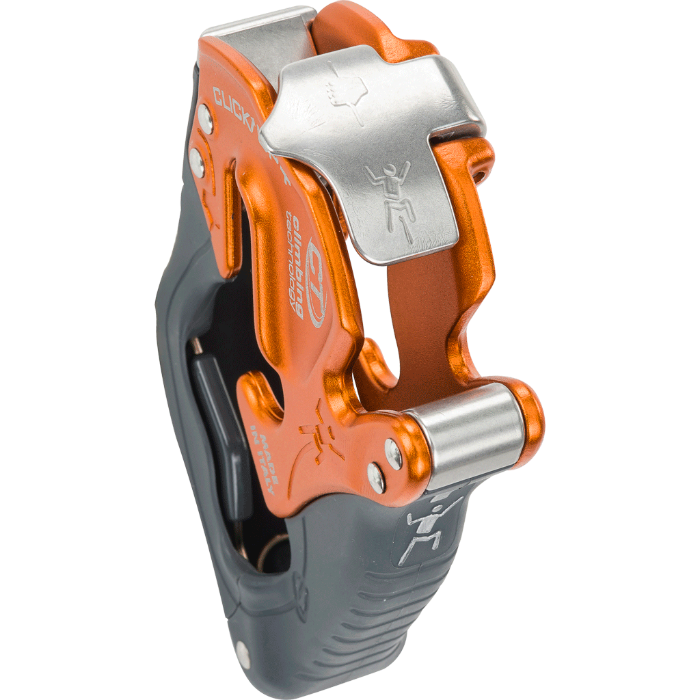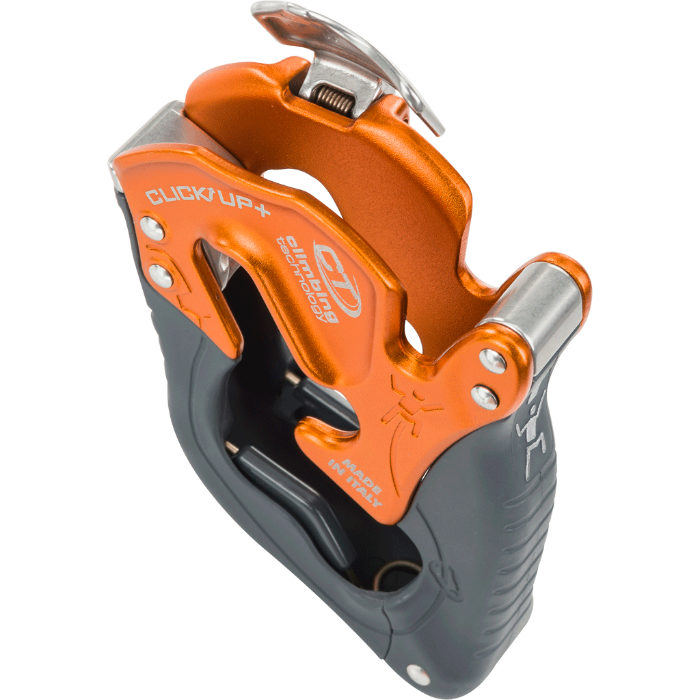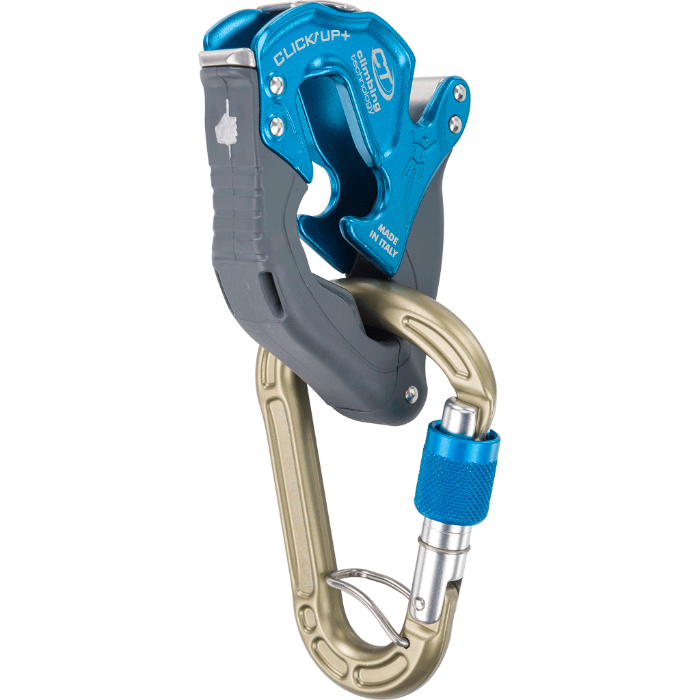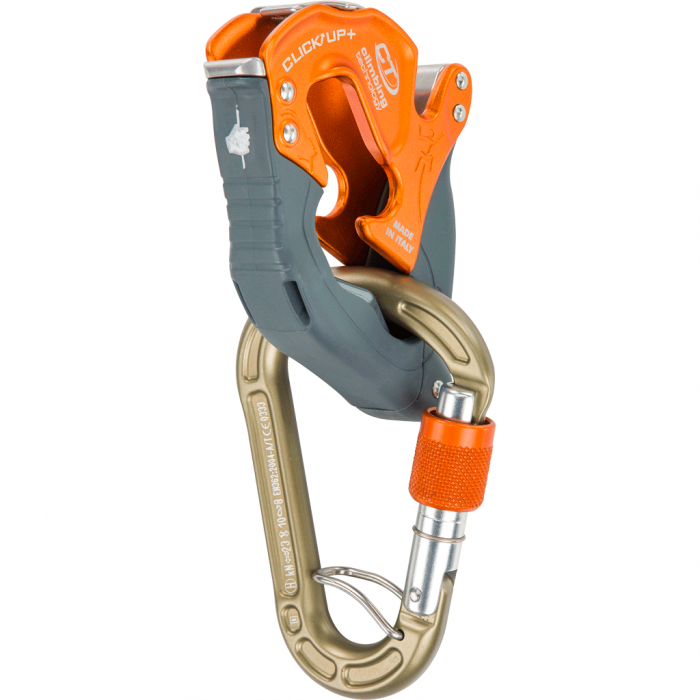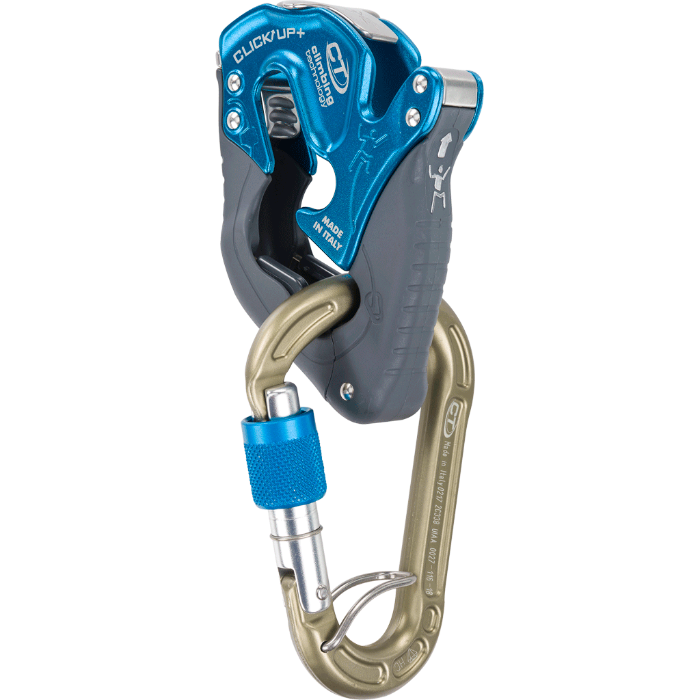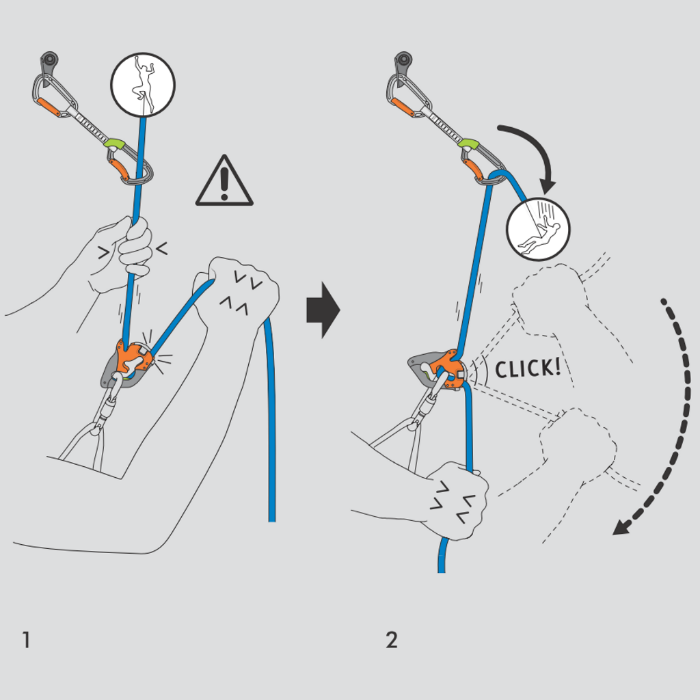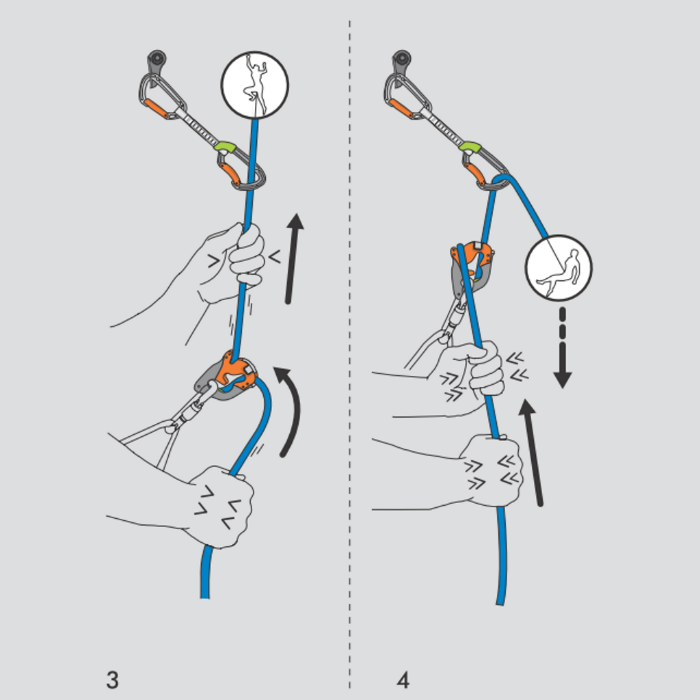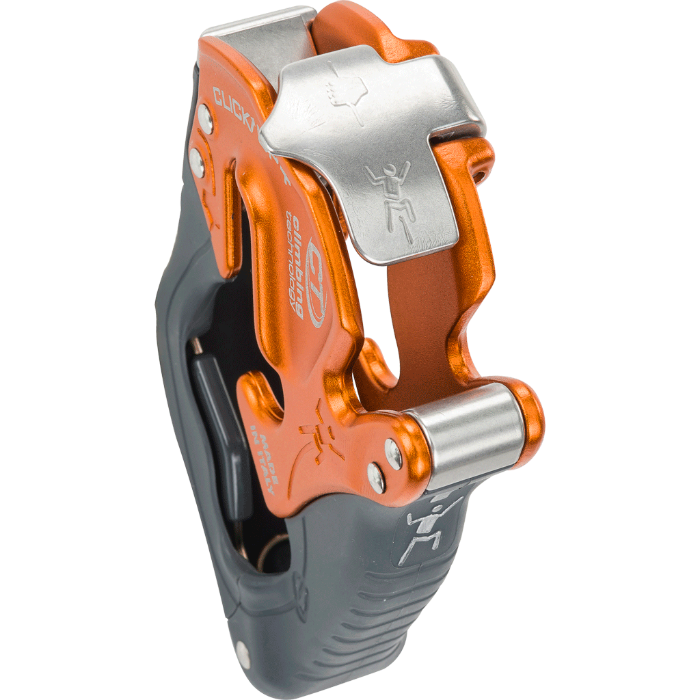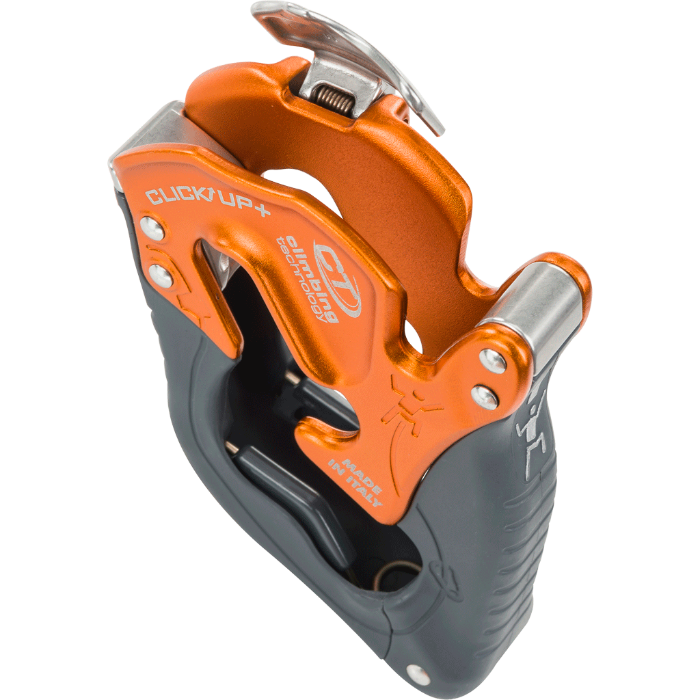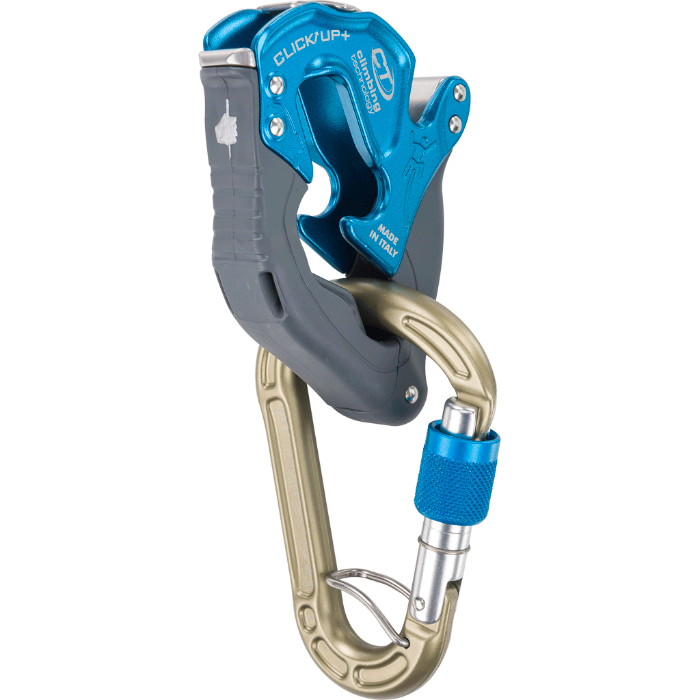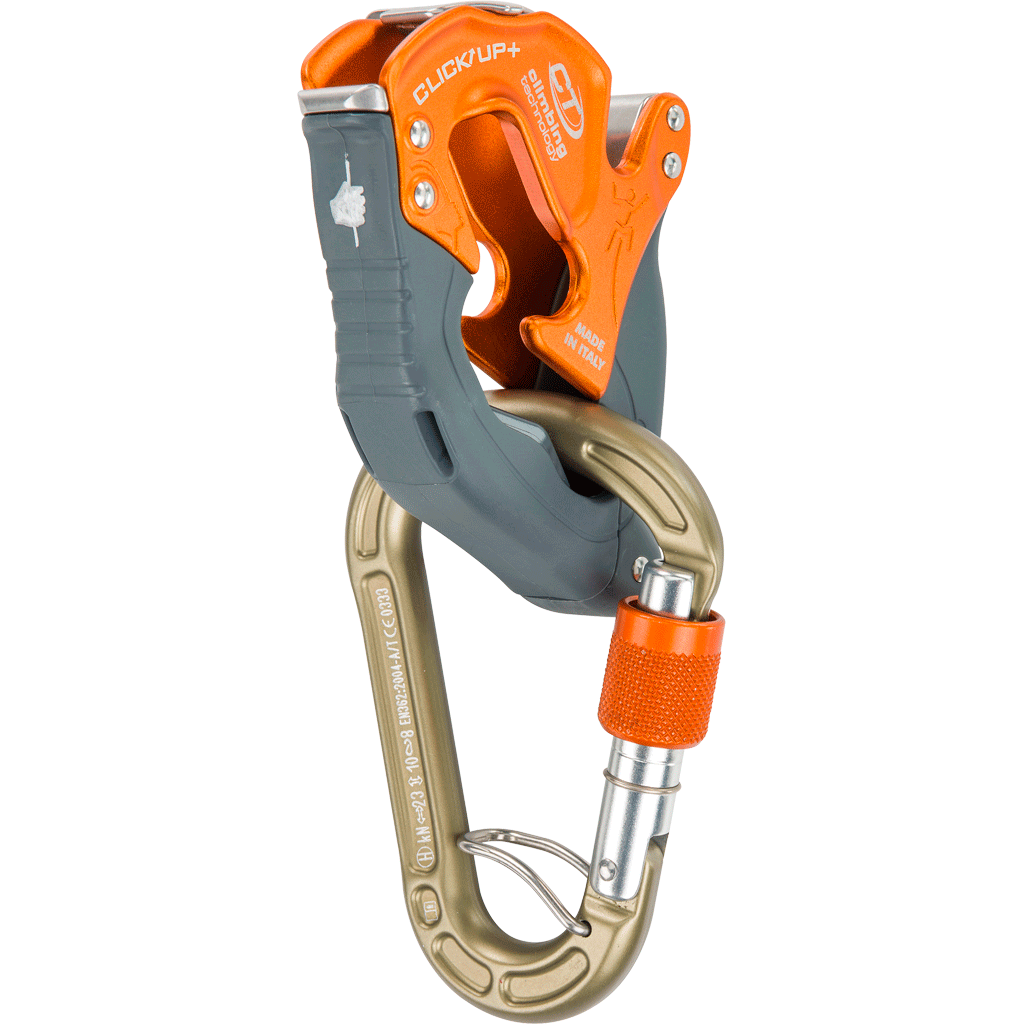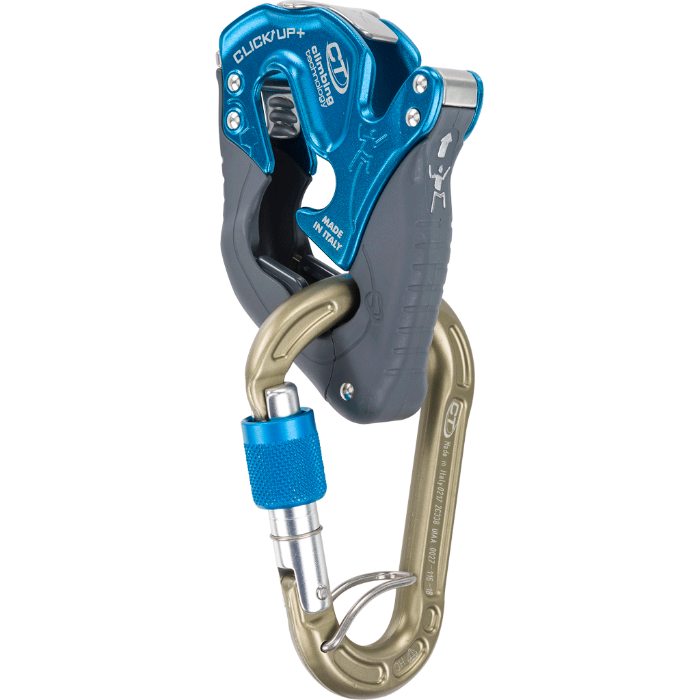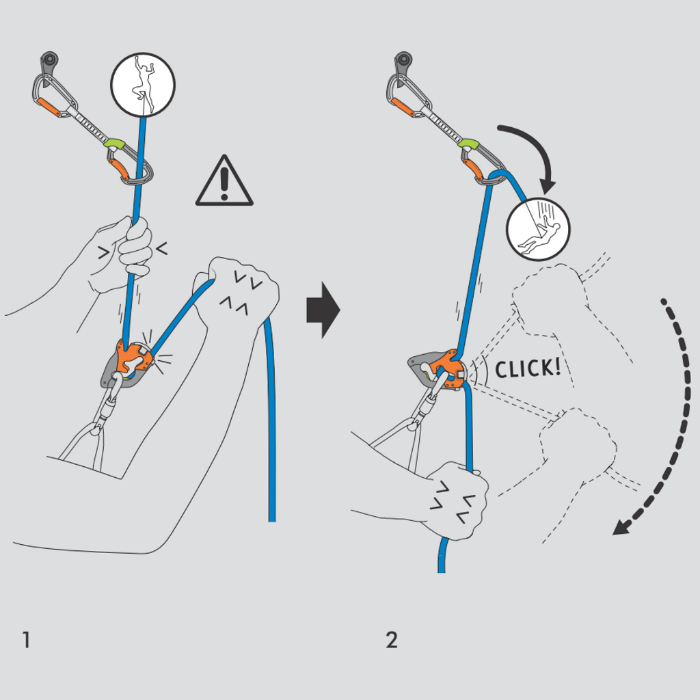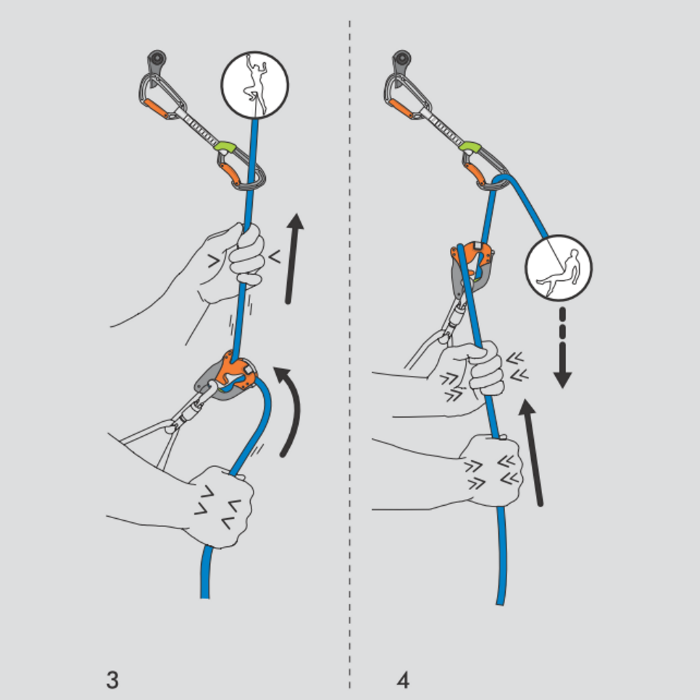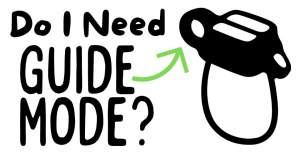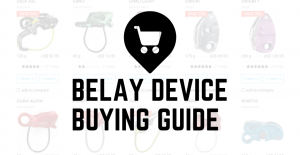How to use Click Up correctly and safely in details with instructional pictures.
Click Up +
Description
CLICK UP + is an innovative manual braking belay device, evolution of the well-established CLICK UP model, that has been available to the public for seven years now. Designed specifically for indoor and crag climbing, it can be used with all dynamic single ropes in the 8.5 to 11 mm Ø range. Lightweight and compact, it allows for belaying a leader or a top-roping climber, both hands handling the rope.
This is what makes the new CLICK UP really ‘+’:
- more effective in paying out rope, a process that is now quick and smooth (Fig. 3), thanks to the new geometry of the body and to a new carabiner holding layout (patent pending);
- more comfortable for top-rope belays, especially when used with indoor climbing ropes, thanks to the new geometry of the side plates;
- even safer, thanks to the V-Proof System (patent pending) that reduces the chance of error due to incorrect handling of the rope while braking (Fig. 1-2);
- more ergonomic, thanks to the new shape of the outer body.
Like the previous model:
- it allows the belayer to arrest a fall simply holding the free end of the rope with the braking hand;
- it allows the belayer to lower the partner off by applying a slight pressure over the device, while keeping under tension the free end of the rope with the braking hand;
- it ensures effective belaying even if the rope is incorrectly installed in the device (the strands of the rope are inverted) thanks to specific V-shaped, tapered, friction notches (Fig. 4).
V-PROOF SYSTEM
When belaying, some processes are critical (like taking-in and paying-out rope to the leader, or taking-in slack during top-roping) and, in the event of a fall, require the V-shaped angle of separation between the two sections of the rope to be maintained. A reduction in the value of this angle can affect the proper functioning of the device when locking the rope.
The V-Proof System, featured on CLICK UP +, reduces the chance of error due to an incorrect reduction of the V-angle between the two strands of the rope.
It consists of a mobile partition that facilitates the activation of the assisted-braking system. If during the fall of the climber the hand side of the rope comes into contact with the partition (Fig. 1), this pressure contributes to the rotation of the device and to the consequent locking on the rope (Fig. 2).
Caution: read carefully the device instructions before use.
CLICK UP + is supplied and must be used together with the specific HMS carabiner CONCEPT SGL HC, with wear-resistant anodizing and ACL system that prevents the possibility of minor-axis cross-loading.
Retail price
This Product is Hard to Find.
We don’t know where you can buy this item online in the US. We’ll continue to check all the major retailers and will update this page as soon as we find one.
If you know where to find this online in the US, let us know, and we’ll add the link.
Device Type  Device TypeTubeThe most commonly used belay type also called an “ATC” or “tuber.” Other than a distinction between other belay device types, “Tube” is a rarely used term, most climbers just assume you're talking about this style when they refer to your "belay device." 
Figure 8Mostly used in rescue, canyoneering, tactical, work safety, or by old school climbers and rappellers. One reason they went out of popularity with recreational climbers is because they tend to create twists in the rope. 
Brake AssistThese devices assist in stopping the rope when a climber falls or hangs on the rope. 
Often referred to as “auto-blocking” but that’s not the official terminology because no belay device should be assumed to work automatically by itself, even if it feels like it does (or does most the time). PlateWhen simplicity is a must, or you started climbing before Tubers were the norm. Bonus: They tend to be very light weight. 
DescenderFor rappelling, not for belaying a lead climber or top-roping. 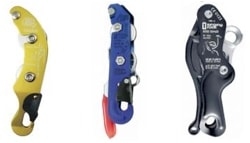 |
Brake Assist - Tube |
Weight (g)  Weight (g)In grams, the weight, as stated by the manufacturer/brand. |
110 g |
Belay Brake Assist  Belay Brake AssistThis is when the belay device significantly reduces the amount of holding power the belayer must exert to stop a fall and hold a climber. This is also called "assisted-braking" as the device must hold a significant amount of the climber’s weight; this term does not include friction-adding "teeth" found on some tube style belay devices. Confusingly referred to as “auto-blocking” or “auto-locking” these terms wrongly imply the device will always, automatically, stop a fall or hold a climber even if the belayer/rappeller is hands-free. These devices are not meant to be used without a hand on the braking side of the rope; the belayers/rapppeller brake hand should always be on the brake rope. Worth ConsideringMost of the mechanical brake assist devices only hold a single strand of rope and are not capable of double-strand rappelling (the most common method of rappel). |
Yes |
| Rope Options | 1 rope only |
Guide Mode  Guide ModeThis is when you belay directly off the anchor instead of your harness. Guide mode is helpful if you climb outdoors a lot because it reduces the holding power required from the belayer. When your partner falls or rests, the weight of the climber is held mostly by the anchor and the belay device. Tubers and PlatesWhen belaying in "guide mode," the tubers and plates turn auto-blocking. During a fall, the climbing rope pinches the slack rope, completely stopping the movement of either rope. A common guide mode setup shown below. 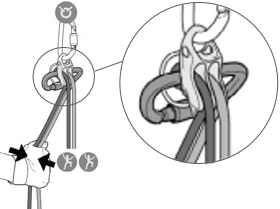
Mechanical Brake Assist DevicesThere is no difference in the functionality of the device. A brake-hand should always be on the rope to ensure the climber is caught in the case of a fall. A common guide mode setup shown below. 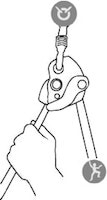
Where guide mode is used
Learn Morehttp://www.climbing.com/skill/essential-skills-auto-blocking-belay-devices/ |
No guide mode |
Teeth  TeethTeeth are only seen on tube devices. They add friction that helps grip the rope for more belaying control. This is helpful for belaying heavier climbers. Teeth are becoming standard on new tube devices. 
Worth ConsideringTeeth do wear out. You can limit wear by rappelling on the side without teeth (if you don’t need the extra friction). Once they’re worn, you’ll still have a usable belay device, just less friction. |
No |
Rope Range (mm)  Rope Range (mm)The range of rope diameters, in millimeters, that the manufacturer/brand specifies can safely be used. This is the best case scenario and does not necessarily take into consideration that certified ropes have a tolerance of +/- .3 mm. Recently, manufacturers have started to add an "optimized" rope range -- this is the range that will result in the nicest handling of the belay device. | 8.5 mm - 11.0 mm |
Certification  CertificationsThe main climbing gear certifications are CE and UIAA--and normally the UIAA creates the rules that the CE body also supports. When possible, we try to list all the certifications the product carries. To sell a climbing product in Europe, the device must be CE certified. There are no official requirements to sell climbing gear in the US. The UIAA certification is a voluntary process. Learn MoreRock and Ice Certifications Guide |
EN |
No reviews yet.
The ClickUp + is an innovative passive assist braking device with a reasonably large following in Europe. We have literally never seen one being used in the US, although that is no reason you shouldn't try it. While it has some solid safety features that are certainly recommendable, we also feel that functionally it is a bit complicated and difficult to master, not to mention a bit expensive compared to competitors.
Overall this is a bit of a disappointment. The feeding mechanism is too sensitive and has been implemented to avoid a problem that the vast majority of climbers would never experience. It is a safer device for top-roping and for belaying with inexperienced climbers, but most people who use the old Click Up will find the new version frustrating. You can adapt your belaying style to make it work almost as well as the original, but you shouldn't have to do that. We are pleased to say though that the brilliant original Click Up is still available!

